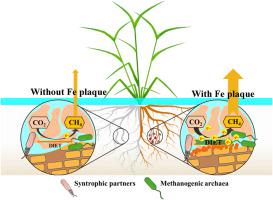当前位置:
X-MOL 学术
›
Soil Biol. Biochem.
›
论文详情
Our official English website, www.x-mol.net, welcomes your feedback! (Note: you will need to create a separate account there.)
Rice root Fe plaque increases paddy soil CH4 emissions via the promotion of electron transfer for syntrophic methanogenesis
Soil Biology and Biochemistry ( IF 9.7 ) Pub Date : 2024-01-31 , DOI: 10.1016/j.soilbio.2024.109332 Jinzhi Yao , Minghui Xie , Linpeng Yu , Ting Liu , Tim J. Clough , Nicole Wrage-Mönnig , Jiafa Luo , Chunsheng Hu , Tida Ge , Shungui Zhou , Shuping Qin
Soil Biology and Biochemistry ( IF 9.7 ) Pub Date : 2024-01-31 , DOI: 10.1016/j.soilbio.2024.109332 Jinzhi Yao , Minghui Xie , Linpeng Yu , Ting Liu , Tim J. Clough , Nicole Wrage-Mönnig , Jiafa Luo , Chunsheng Hu , Tida Ge , Shungui Zhou , Shuping Qin

|
Iron (Fe) plaque is a concentrated form of microbially available Fe oxide that coats rice plant root surfaces, representing a high density of Fe oxide and which potentially mediates paddy soil CH emissions. Using a combination of methods including Fe plaque induction, isotopic labeling, pure microbial strains, and Fe oxide addition experiments, we investigated the impact of Fe plaque on methane (CH) emissions from paddy soils and explored the associated mechanisms underlying the influence of Fe plaque on CH emissions. A C–CH isotopic labeling experiment showed that Fe plaque did not significantly affect CH oxidation and associated gene expression, whereas Fe plaque significantly enriched methanogenic archaea and their expression of genes associated with methanogenesis. Pure microbial strain and Fe oxide addition experiments showed that the enhancement of CH production in the presence of Fe plaque was caused by the (semi) conductive minerals within the Fe plaque, specifically, hematite, which promoted the extracellular electron transfer between the methanogenic archaea and their syntrophic bacteria, resulting in enhancement of methanogenesis. Our results imply that the presence of Fe plaque will accelerate CH emissions from paddy soils and suppressing Fe plaque has the potential to mitigate CH emissions.
中文翻译:

水稻根部铁斑通过促进互养产甲烷的电子转移增加稻田土壤甲烷排放
铁 (Fe) 斑块是微生物可利用的氧化铁的浓缩形式,覆盖在水稻根部表面,代表高密度的氧化铁,可能介导稻田土壤 CH 排放。综合运用铁斑诱导、同位素标记、纯微生物菌株和氧化铁添加实验等方法,研究了铁斑对水稻土甲烷(CH)排放的影响,并探讨了铁斑影响的相关机制。关于 CH 排放。AC-CH同位素标记实验表明,Fe斑块不会显着影响CH氧化和相关基因表达,而Fe斑块显着富集产甲烷古菌及其与产甲烷相关的基因表达。纯微生物菌株和 Fe 氧化物添加实验表明,在 Fe 斑块存在的情况下,CH 产量的增强是由 Fe 斑块内的(半)导电矿物质(特别是赤铁矿)引起的,它促进了产甲烷古菌和产甲烷古菌之间的细胞外电子转移。它们的互养细菌,导致产甲烷作用增强。我们的结果表明,铁斑的存在将加速稻田土壤中 CH 的排放,抑制铁斑有可能减少 CH 排放。
更新日期:2024-01-31
中文翻译:

水稻根部铁斑通过促进互养产甲烷的电子转移增加稻田土壤甲烷排放
铁 (Fe) 斑块是微生物可利用的氧化铁的浓缩形式,覆盖在水稻根部表面,代表高密度的氧化铁,可能介导稻田土壤 CH 排放。综合运用铁斑诱导、同位素标记、纯微生物菌株和氧化铁添加实验等方法,研究了铁斑对水稻土甲烷(CH)排放的影响,并探讨了铁斑影响的相关机制。关于 CH 排放。AC-CH同位素标记实验表明,Fe斑块不会显着影响CH氧化和相关基因表达,而Fe斑块显着富集产甲烷古菌及其与产甲烷相关的基因表达。纯微生物菌株和 Fe 氧化物添加实验表明,在 Fe 斑块存在的情况下,CH 产量的增强是由 Fe 斑块内的(半)导电矿物质(特别是赤铁矿)引起的,它促进了产甲烷古菌和产甲烷古菌之间的细胞外电子转移。它们的互养细菌,导致产甲烷作用增强。我们的结果表明,铁斑的存在将加速稻田土壤中 CH 的排放,抑制铁斑有可能减少 CH 排放。



























 京公网安备 11010802027423号
京公网安备 11010802027423号